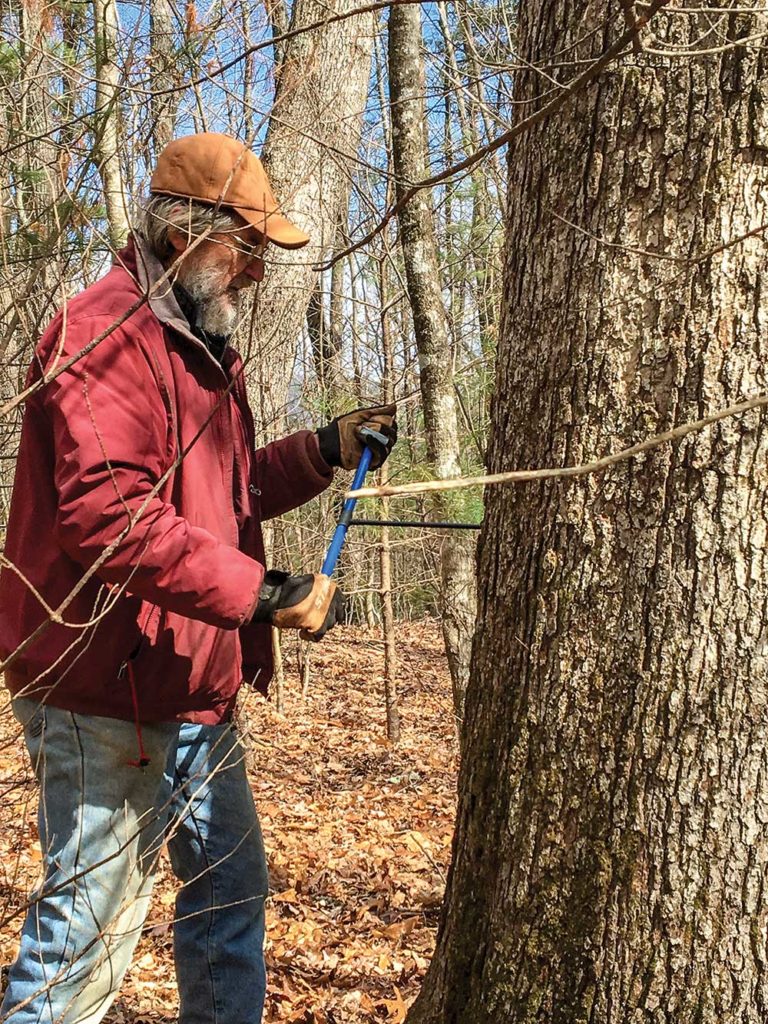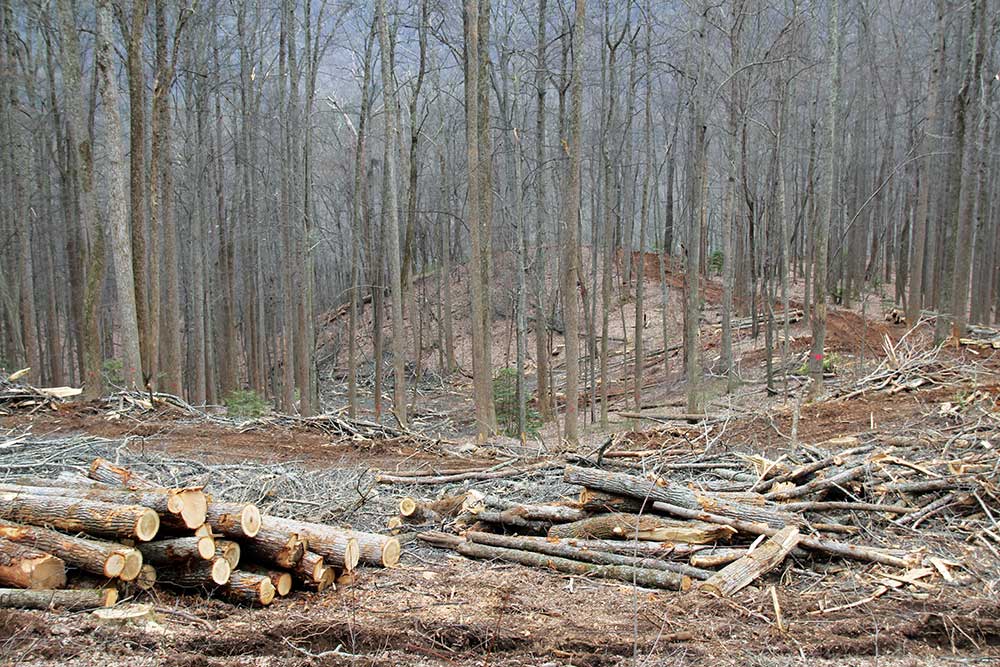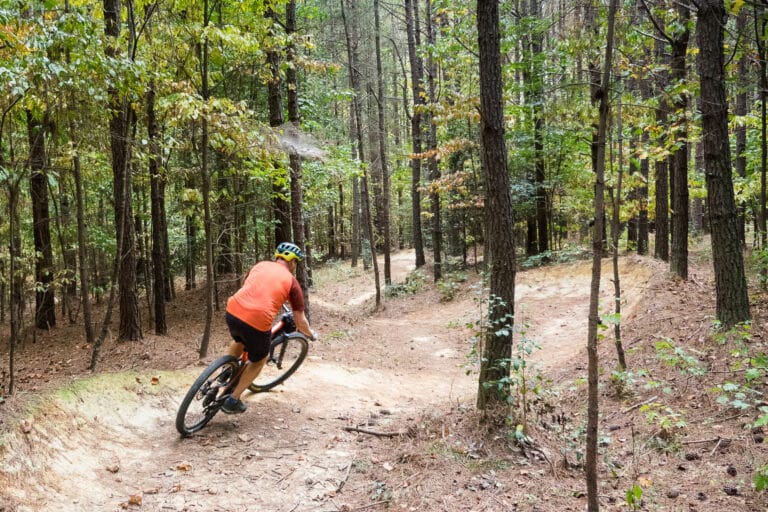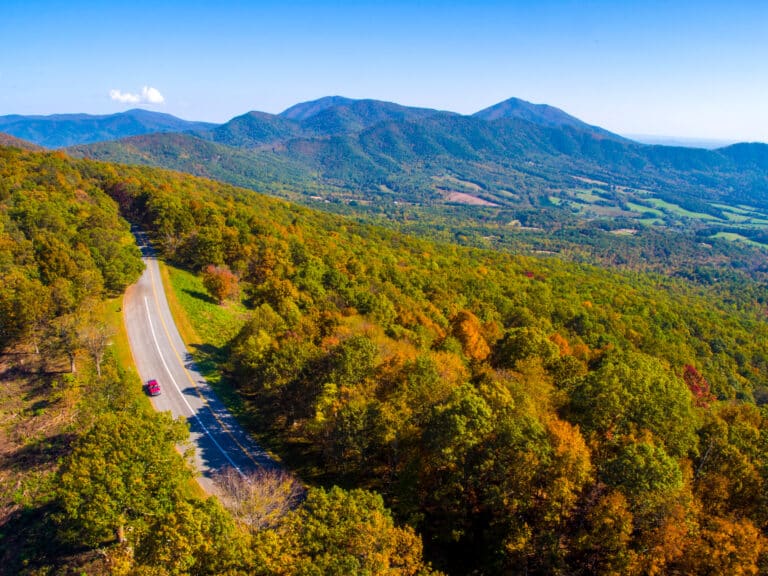Trump’s New Timber Rule Threatens the Future of Our National Forests
Be it salamander, newt, frog or toad, Asheville biologist J.J. Apodaca professes to be equally protective of all amphibians.
Press him hard enough, however, and he reveals a soft spot for the green salamander. Over millennia, these ancient, lungless vertebrates have created an intricate relationship with old growth, temperate rain forests of the Southern Appalachians.
Each spring, green salamanders emerge from their winter hideouts deep in rock crevices and climb giant, native trees. Grooved barks and hollows provide refuges as they dart about feasting on insects. By late summer, females retreat to the rocks, scouting out perfect hidden chambers for egg-laying.
Unlike some other amphibian mothers who leave the “nest” quickly, this plucky green parent-to-be—all three to five inches of her—stands guard, coating her eggs with skin secretions to ward off killer bacteria, viruses and other pathogens.
That tender, protective act is just one reason Apodaca is speaking up for saving this at-risk species, now being considered for endangered status. He fears a little-noticed Trump administration directive to the U.S. Forest Service to log more board feet of timber threatens the salamanders’ very existence.
“We have to take a stand for the things we care about on public lands,” said Apodaca, director of science for the Amphibian and Reptile Conservancy. “The choice we have as a society is: do we value biodiversity or do we just value timber production?”
The executive order, quietly rolled out four days before Christmas in the name of curbing wildfires, calls on the Forest Service to boost its nationwide timber output by 31 percent—to 3.8 billion board feet from the 2.9 billion cut in 2017.
Ecologists view the order as a smokescreen. Out West, logging isn’t an antidote for huge, intense, and deadly wildfires. Thinning might make sense near homes, fire specialists say, but cutting trees won’t halt fires when weather extremes caused by climate change are becoming the norm.
“We have to take a stand for the things we care about on public lands. The choice we have as a society is: do we value biodiversity or do we just value timber production?”
– J.J. Apodaca, Amphibian and Reptile Conservancy
In the Southeast, where such catastrophic fires are extremely rare, the order is seen as a ruse to promote unsustainable logging in one of the country’s prime timber baskets. Yes, the region has plenty of dry, south-facing slopes, but wildfires in what’s classified as temperate rain forest are generally localized and don’t run amok.
After decades of suppressing wildfires, the Southeast has adopted a strategy of restoring historic, natural fire regimes via prescribed burns on private and public lands. It’s these controlled fires—not logging—that reduce fuel loads in forests and keep fire-dependent ecosystems such as the long-leaf pine healthy.
“For all the rhetoric about wildfire, the Forest Service is going to look for rich, moist forests that grow big trees. And those are in the South,” said Sam Evans, an attorney at the Southern Environmental Law Center’s Asheville office since 2011. “This will take a toll on our forests.”
Nobody outside the agency can say exactly what Trump’s executive order means for the Nantahala-Pisgah National Forest. But Apodaca and Evans are paying close attention because the Forest Service is on the cusp of releasing a draft plan that spells out how those 1.1 million acres in North Carolina will be managed over the next 30 years.
Globally, the region is valued as a biodiversity hotspot, a wildlife corridor, a drinking water source, and a haven for paddlers, hikers, and bicyclists.
Local conservationists say the loophole-laden order will be a mammoth setback to hard-fought gains sought to balance preservation of natural resources, recreational access, and livelihoods in local communities.
They are alarmed that the order instructs the Forest Service to undermine the scientific review, public participation, and oversight that keeps trees standing and salamanders thriving.
“Basically, the Forest Service would be able do what they want to do. If we get wind of what’s going on, the only way we could intervene is to take them to federal court,” Evans said. “There would be no conversation and no chance to comment.”
Already, the law center has resorted to a Freedom of Information Act lawsuit to discover how 3.8 billion board feet will translate to logging quotas in the Nantahala-Pisgah Forest.
Transparency and accountability cast aside
Skirting transparency required by long-hallowed rules such as the Endangered Species Act and the National Environmental Protection Act in the name of expediency would be wrong, Evans said.
“All agencies are supposed to be accountable to the public,” he said. “Shorting public participation in the name of increasing board feet can create bitter social conflicts. That’s what is at stake.”
Indeed, Trump’s order is nowhere near the peak of 12 billion board feet harvested in the late 1980s, but it would double the 2009 low of 1.9 billion.
Still, the jump from 2.9 billion board feet in 2017 to 3.4 billion in 2018 has Evans on edge because it mimics an uptick during the middle of George W. Bush’s two-term presidency.
Between 2003 and 2006, the harvest climbed 62 percent, according to Forest Service numbers. And 43 percent of that came from the South, even though the region has only 6.9 percent (13 million acres) of Forest Service lands.
“We’re headed for exactly that, if you look at the trend line,” said Evans, who leads the law center’s national forests and parks program. “And as the Forest Service ramps up, the biggest tragedy is the hit to its reputation. It will not recover for decades.”
But Forest Service spokeswoman Cathy Dowd said the agency sees the executive order as beneficial for tackling wildfires, invasive species, insects, disease and other land management challenges.
“We understand the concern some have about these new authorities,” she said about what the agency considers a new tool “to help us accomplish our mission of sustaining the health, diversity and productivity of the nation’s forests.”
The Forest Service released a preliminary draft of the Nantahala-Pisgah plan in 2014. Immediately, there was widespread opposition to the Forest Service’s proposals for logging in remote areas with high concentrations of old growth and rare habitats.
Such intense pushback prompted planners to promise a reboot, but conservationists say the agency has adopted a culture of secrecy during the do-over.
“Lately, they haven’t shared anything substantive,” Evans said. “I think that’s a mistake. You can’t get buy-in without getting feedback from the public.”
Meanwhile, the Forest Service is proceeding with several timber management projects presented in that preliminary draft. Those include the Twelve Mile, Southside. and the Buck logging projects.
Twelve Mile Project exceeds expectations
Evans called Twelve Mile, a 20,000-acre project in Haywood County, N.C., one that “would pass muster as a good plan.” A portion of it involves improving elk habitat, and it’s adjacent to Great Smoky Mountains National Park and Interstate 40.
Evans praised Jason Herron, the Twelve Mile project lead, for adhering to what should be the agency’s guiding principles of transparency, accountability and public participation—ones that the executive order is intent on shredding.
Beginning in summer 2016, the agency invited interested parties to a series of Twelve Mile meetings and field trips. Herron said the gatherings allowed participants to parse out conflicts, data needs, and partnership possibilities.
“These collaborative engagement tools are useful because they create a framework where all participants can have an opportunity … to learn,” he said. “My key takeaway is the trust and partnership that have been elevated.”
Herron said he expects to release the Twelve Mile environmental analysis for public comment in April or May. The project calls for trees to be cut on about 2,400 acres; roughly 1,900 of those acres involve commercial timber sales.
What Evans finds promising is how it calls for “cutting trees in the right places” instead of going after old growth trees and areas valued for recreation and natural heritage.
“I’m not saying it is all perfect, but I watched how hard Jason worked to get this project right,” Evans said. “I’m really impressed with the care the Forest Service took to incorporate feedback.”
That give and take is what seeded more community cooperation than conflict, he said.
Southside receives all-around thumbs down

On the other hand, Evans joins most conservationists with his lack of enthusiasm for the Southside projects environmental assessment completed in mid-February by Nantahala District Ranger Mike Wilkins. The project’s 19,000 public acres are east of Highlands, straddling Macon and Jackson counties.
Chief among their complaints are that it sacrifices too much salamander habitat by replacing mature trees with early successional forests that deer, turkey, bear, rabbit, and other game species count on and hunters favor.
They are also upset that logging is proposed on some sensitive areas that could be recommended as wilderness areas in the 30-year plan.
Critics say these “bad tradeoffs” are a precursor for what will unfold in the Southern Appalachians, especially when an underfunded Forest Service is directed to harvest more board feet.
Apodaca, the scientist, knows that logging big old trees too close to known salamander populations will limit the amphibians’ access to mates, thus leading to inbreeding and die-offs. Massive losses of chestnuts and hemlocks have already added to the creature’s habitat woes.
While Wilkins’ vow to leave 328-foot buffers of trees around rocky outcrops sounds promising, scientists said such buffers will instead dry out the forest as rhododendrons and other shrubby plants grow in the clearings.
“The idea of a buffer pays lip service to a rare species rather than paying attention to its full recovery,” Apodaca says. “All you’re doing is creating a postage stamp of a zoo for salamanders. It’s a myopic view of species management.”
What also upsets Apodaca is that plenty of board feet could be harvested elsewhere in the Nantahala-Pisgah Forest that wouldn’t put the squeeze on at-risk species.
Wilkins said that although he was “disappointed we could not make everyone happy,” trade-offs are part of the process.
“We make decisions based on the best possible science,” he continued. “Forests need diversity and all ages of trees. What’s missing from the Southside area is young forest.”
Wilkins expects to start the Southside timber projects in 2021.
It’s the “where” that matters
Apodaca and Evans emphasize that as conservation science has evolved, where the Forest Service cuts trees matters hugely. And choosing those places means dedicating time, care, and resources to getting it right.
However, when more money is shifted to fill the timber sales pipeline quickly, everything else, from public participation to trails to research, is squeezed.
“The money has to come from somewhere, so they spend less by taking shortcuts,” Evans said. “The science of ecological forest management takes a lot of staff time and it’s really hard when it’s complicated by rare species and the interests of lots of recreational users.
“You can’t design an activity to benefit one resource without affecting another, so you have to keep all of them in mind.”
Everybody loses when a district ranger can’t—or won’t—take the time to conduct comprehensive green salamander surveys before rolling out projects such as Southside, says Apodaca. At best, he said, the information presented was cursory, inaccurate, and inadequate.
It’s shameful, Evans said, when the Forest Service doesn’t have a big enough budget to devote the proper number of biologists, botanists, and other staffers to conduct proper scientific studies.
“The big picture is that the Forest Service knows how to do all of this the right way and do it well,” Evans said. “It’s when it chases bad and controversial work that it shuts down relationships between people and the land.”
Dowd, the Forest Service spokeswoman, didn’t directly answer a question about whether a mandate to significantly increase logging would compromise biodiversity in the Southern Appalachians.
“Even with this new timber volume goal, we will continue to manage our forests in accordance with our forest management plans,” she said, adding that healthy and resilient forests depend “on our ability to increase work on the ground and achieve better outcomes.”
The Fight for Old Growth
Like the law center, the nonprofit Chattooga Conservancy is part of the Nantahala-Pisgah Forest Partnership. The partnership is a cross-section of local stakeholders offering the Forest Service specific recommendations as the 30-year plan is shaped.
One reason the conservancy, founded in Clayton, Ga., in 1994, opposes tree cutting laid out in the Southside project is because of potential harm to the watershed of the Chattooga, a wild and scenic river that flows from North Carolina.
Executive Director Nicole Hayler wants Southside to be withdrawn until the new Nantahala-Pisgah Forest Plan is in place because she says the project doesn’t preserve enough existing old growth and is based on outdated and inadequate science.
For instance, she said it’s ecologically unsound for iconic landmarks such as 3,500-foot Brushy Mountain and an area near the Granite City boulder field to be included among the 16 separate areas across 317 Southside acres that will be logged to make way for early successional habitat.
Last fall, two student researchers at the Highlands Biological Station, which is affiliated with the University of North Carolina, took core samples of trees in sections of 26-acre Brushy Mountain and 20-acre Granite City.
Ring counts revealed trees that qualify as old growth. For instance, a white oak on Brushy Mountain was found to be at least 211 years old. In Granite City, the students found a 127-year-old white oak and a 145-year-old northern red oak. A separate core sample revealed a 180-year-old red oak.
“They just need to be left alone,” Hayler said about those trees.
Granted, the students didn’t have time to sample every tree, she said, but even their limited data proved that Wilkins wasn’t diligent enough about conducting on-the-ground science.
Wilkins countered that the 16 stands identified for regeneration or thinning, which include Brushy Mountain and Granite City, “do not meet the definition of old growth. They have some old trees, but they are all stands that display evidence of past management activity.”
He also said that no timber management is planned for Granite City proper because the boulder field popular with visitors has been “set aside for recreation and visuals.”
Hayler said she understands that. Her concern is with a section of existing old growth targeted for cutting that is roughly 1,500 feet from the rocky landscape, and considered part of the Granite City area.
The Forest Service should focus on connecting patches of existing old growth to preserve rare resources and help the green salamander recover, she said.
“We have to ramp up protection in these areas, not open them up to more extraction,” Hayler said.
Wilkins pointed out that close to 7,000 acres—more than one-third of the 19,000 acres comprising Southside—are set aside as designated old growth. Within a decade, 11,000 acres will be at least 100 years old and moving toward old growth, he says.
“The Southside project does not diminish the old-growth character of the analysis area,” he said.
Hayler said the Forest Service’s use of the word “designated” misleads the public because right now such trees are much too young to qualify as old growth—and might never.
Her conservancy is afraid that the 30-year-plan won’t adequately protect existing old growth because input is coming from the same Forest Service managers that approved Southside.
Will rare salamanders be lost to the cut?

Any conversation about defining old growth trees, never mind forests, is tricky, especially in a region denuded of so many trees before the Forest Service started managing Pisgah in 1916 and Nantahala in 1920.
After forests re-grew, citizens became fiercely protective of their incomparable natural resources. That’s partially why public blowback to the last Nantahala-Pisgah Forest Plan, released in 1987, was so ferocious. It called for volumes of clear-cutting that were even opposed by counties with long histories of timber-based economies. The Forest Service responded to that outcry by scaling the practice way, way back.
A Forest Service guidance document defines the minimum age for old growth in the South as between 120 and 140 years, depending on species mix, moisture, fire risk and other factors.
Studies show that the Nantahala-Pisgah Forest is home to roughly 90,000 acres of the estimated 250,000 acres of old-growth forest left standing in the Southern Appalachians. Many of those trees have lived well beyond 140 years.
Tragically, industrial-scale clear-cutting at the turn of the 20th century was intense. After logs were floated down rivers and loaded onto trains, denuded mountainsides eroded and rootless soil cascaded into waterways, destroying habitat for fish, birds, amphibians, mammals and other species.
Any conversation about managing old growth circles back to the green salamander.
Apodaca, the amphibian expert who spoke up for the silent salamander as the Southside project was shaped, said Trump’s executive order will mute people’s voices, too.
“If we raise concerns and still these projects are pushed through anyway, why even have public comment?” he asked.
“If you want more board feet, that will trickle down to amphibians and all the other goals and priorities people value public lands for,” he continued. “It’s hard but not impossible to manage all of these things concurrently.”
Apodaca wonders how many people are aware that the Southern Appalachians are the world’s salamander capital. He aligns with author Barbara Kingsolver’s idea that if the region designed a flag, the amphibian should be its centerpiece.
“Salamanders are to Southern Appalachia what the buckeye is to Ohio,” he said. “It’s part of our natural history that we should value and cherish.”
Elizabeth H. McGowan is a longtime energy and environment reporter who lives in Washington, D.C. She won a Pulitzer Prize for National Reporting in 2013.







